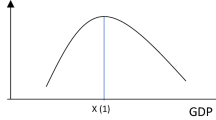Abstract
Anthropogenic greenhouse gases (GHG) emission and related global warming issues have been the focus of international communities for some time. The international communities have reached a consensus to reduce anthropogenic GHG emissions and restrain global warming. The quantitative assessment of anthropogenic GHG emissions is the scientific basis to find out the status of global GHG emission, identify the commitments of each country, and arrange the international efforts of GHG emission reduction. Currently the main assessment indicators for GHG emission include national indicator, per capita indicator, per GDP indicator, and international trade indicator etc. The introduction to the above indicators is put forward and their merits and demerits are analyzed. Based on the GHG emission data from the World Resource Institute (WRI), the US Energy Information Administration (EIA), and the Carbon Dioxide Information Analysis Center (CDIAC), the results of each indictor are calculated for the world, for the eight G8 industrialized countries (USA, UK, Canada, Japan, Germany, France, Italy and Russia), and the five major developing countries including China, Brazil, India, South Africa and Mexico. The paper points out that all these indicators have some limitations. The Indicator of Industrialized Accumulative Emission per Capita (IAEC) is put forward as the equitable indicator to evaluate the industrialized historical accumulative emission per capita of every country. IAEC indicator can reflect the economic achievement of GHG emission enjoyed by the current generations in every country and their commitments. The analysis of IAEC indicates that the historical accumulative emission per capita in industrialized countries such as UK and USA were typically higher than those of the world average and the developing countries. Emission indicator per capita per GDP, consumptive emission indicator and survival emission indicator are also put forward and discussed in the paper.
Similar content being viewed by others
References
Ahmad Nadim, 2003. A Framework for Estimating Carbon Dioxide Emissions Embodied in International Trade of Goods. OECD, Paris.
Carbon Dioxide Information Analysis Center. Global, regional, and national fossil fuel CO2 emissions. http://cdiac.ornl.gov
IPCC, 2007. Climate Change 2007: The Physical Science Basis. IPCC Secretariat.
Ren Guoyu, Xu Ying, Luo Yong, 2002. The status and history of CO2 emission from world countries. Meteorological Science and Technology, 30(3): 129–134. (in Chinese)
Ruddiman W, 2003. The anthropogenic greenhouse era began thousands of years ago. Climate Change, 61: 261–293.
Ruddiman W, Thomson J, 2001. The case for human causes of increased atmospheric CH4 over the last 5000 years. Quaternary Science Reviews, 20: 1769–1777.
Tyndall Center for Climate Change Research, 2007. Who owns China’s carbon emissions? Tyndall Briefing Note No.23, October 2007.
UNFCCC. Kyoto Protocol. http://unfccc.int/kyoto_protocol/items/2830.php
United Nations Population Fund. State of World Population 2007. UNFPA, 2007.
US Census Bureau. IDB-Rank countries by population. http://www.census.gov/ipc/www/idbrank.html
US Energy Information Administration, 2006. International Energy Annual 2004.
US Government. Clear Skies & Global Climate Change Initiatives. http://www.whitehouse.gov/news/releases/2002/02/20020214-5.html
Wang Weizhong, Chen Bin, Lu Chuanyi et al., 2002. The Koyto Protocol and allocation of carbon emission permits. Journal of Tsinghua University (Philosophy and Social Sciences), 17(6): 81–85. (in Chinese)
World Bank. DDP data. http://ddp-ext.worldbank.org
World Resource Institute. CO2 emissions series data. http://www.wri.org
Zhu Xingshan, Liu Xuyi, Xu Huaqing, 1998. The fairness and efficiency problem of action to address climate change. Environmental and Sustainable Development, (3): 6–11. (in Chinese)
Author information
Authors and Affiliations
Corresponding author
Additional information
Foundation: The Key Project for Knowledge Innovation Program of CAS, No.KZCX2-YW-501; The Western Talent Project of CAS in 2005; The National S&T Pillar Program, No.007BAC03A11-05
Author: Zhang Zhiqiang (1964–), Ph.D and Professor, specialized in the study of ecological economics & regional sustainable development and the strategic research on the development of Earth science.
Rights and permissions
About this article
Cite this article
Zhang, Z., Qu, J. & Zeng, J. A quantitative comparison and analysis on the assessment indicators of greenhouse gases emission. J. Geogr. Sci. 18, 387–399 (2008). https://doi.org/10.1007/s11442-008-0387-8
Received:
Accepted:
Published:
Issue Date:
DOI: https://doi.org/10.1007/s11442-008-0387-8




